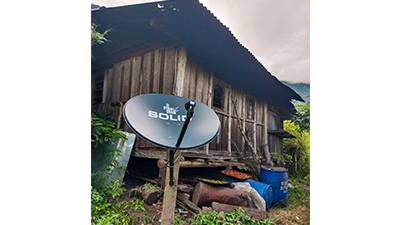 Many rural areas in the country still do not have cable television services. However, this year, access to television has become important for the villagers with the Local Government election just around the corner. Recently, about 3,000 households in Zhemgang installed Ku-band dish cable service. Bhutan InfoCom and Media Authority in collaboration with the Department of Information and Media initiated it.
Many rural areas in the country still do not have cable television services. However, this year, access to television has become important for the villagers with the Local Government election just around the corner. Recently, about 3,000 households in Zhemgang installed Ku-band dish cable service. Bhutan InfoCom and Media Authority in collaboration with the Department of Information and Media initiated it.
Pema Lhendup in Berti village recently installed the Ku-band dish. Ku-band dish is a satellite dish receiver that can receive the television signals through the Ku-band frequencies. It cost between Nu 4500 and Nu 5000 for a set including the installation charge. And the villagers need not pay the monthly bill.
Now, Pema and his fellow villagers can watch and listen to six local TV and Radio channels in his home. He hopes to stay updated with the LG election.
Until today, he had to walk about 4 kilometres to his neighbour’s house to watch news and programs.
“In absence of TV channels, we have to go to Tingtibi town. The cable operator is reluctant to provide the service here because of long-distance and expenses incurred. But now, I am very happy that I can access TV channels. It is also cheaper as it cost just Nu 5000. Now I can watch about LG election and other news happening in the country,” said Pema Lhendup.
 Like him, other villagers are equally happy with the cable service.
Like him, other villagers are equally happy with the cable service.
“Installing BBS channel is beneficial because I can watch entertainment programs and news on time,” said Cheki Gyeltshen, a resident of Dakpel village in Nangkor Gewog.
Only the permit holders are allowed to supply the dish cable service.
“We install Ku-band dish where there are no cable services in the rural areas. Through this permit, we install the BBS1 and BBS2 and also recently launched BBS channel -3 and few radio FM signals like Kuzoo,” said Ugyen Tshering, supplier of Ku-band dish.
The dish operator plans to visit the places once a year for maintenance, in case of damages. The installation of the dish was started in 2019 and will continue till next year, covering eight dzongkhags with 39,000 households.
Pema Samdrup, Zhemgang
Edited by Tshering Zam






